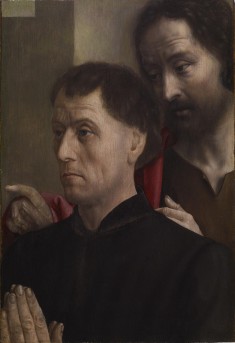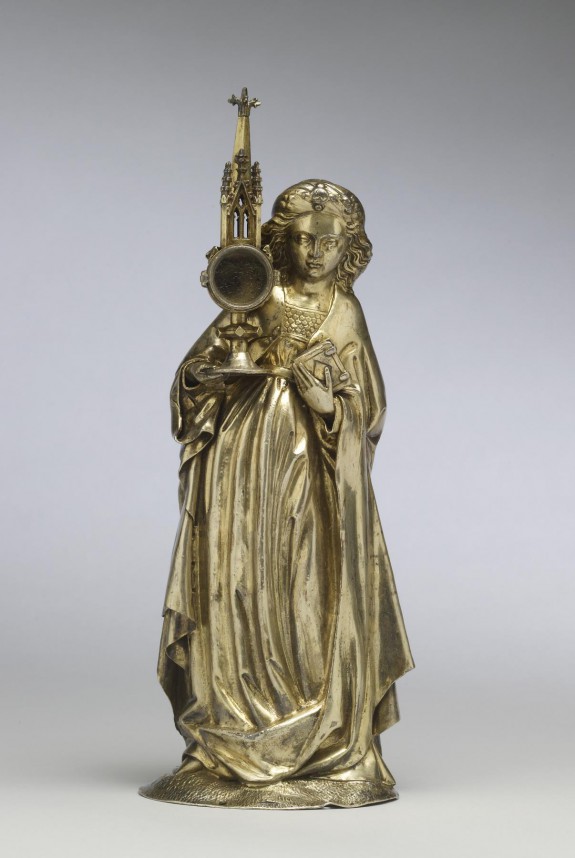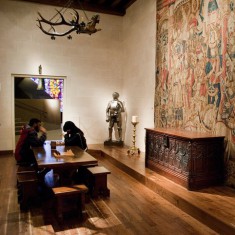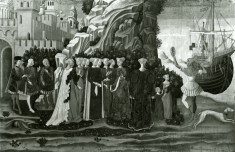In the late 14th and beginning of the 15th century in Europe, two competing popes sat in separate papal courts, the Hundred Years' War continued, and feudalism declined. In general, people began to take a serious interest in the natural world, and to focus on their individual experiences in that world. As a consequence, individuals began to believe that their opinions mattered, and to ask more questions to determine if prevailing thoughts and ideas correlated with their own experience. This was a huge shift in the mental life of Europeans, who had been taught throughout the medieval era that the only approved thought came from the Church and the only important experience took place in the church services. This shift also had a huge impact on art.
Around the turn of the 15th century, cultural centers such as Siena, Avignon and Dijon became known for their sophisticated and international character, and travel and trade took artists all over Europe so that artistic ideas were spreading. Patrons commissioned works in the International Gothic style, a graceful, courtly style which prevailed in Europe circa 1400. The hallmarks of this International Style in painting included slender graceful figures, richly detailed portrayals of fabric and jewelry, and a liberal use of gold.
Joaneath started our tour in the International Gothic room by discussing this Virgin and Child on a Throne. She directed us to notice at least three focal points: Mary's face, her lap, and her feet. Partly because of the size of this picture, the viewer is part of the experience. The viewer is also given lots of clues to use to interpret the experience:
Mary is here both virgin and mother. She is Queen of Heaven holding her son, but her long, unbound hair is uncovered- appropriate to a young maiden. The lilies further symbolize her virginal purity, while the roses signify her motherly compassion. Christ's dual nature is also revealed. His robe is trimmed with ermine (worn only by kings), but he plays with his mother's winding spool. According to popular pious meditations, when the Holy Family reached Egypt, Mary sewed and spun cloth to keep them from starving; like a good boy, Jesus helped her.
In the 15th century, the Dukes of Burgundy became very powerful, establishing splendid courts in their own cities. Trade was robust and new credit and exchange systems required new financial arrangements. One major source of Burgundian wealth was Bruges, known for its wool trade and eventually becoming a financial clearinghouse for all of Europe. The Dukes of Burgundy were major patrons of the arts, and Flemish art thrived in the 15th century.
A fascination with the specific and tangible in the visible world was one of the chief characteristics of Flemish art during this period. That, coupled with the adoption of oil-based pigments for painting, led to this being a great age for portraiture. Joaneath directed us to this small panel, cut down slightly at the top and bottom. It was originally the right wing of a small altarpiece made of only two paintings, known as a diptych. The subject of the left wing would have been the Virgin and Child. It is to them that Saint John (the patron saint of the donor) directs the praying donor's devotion. The donor is shown completely absorbed in the vision. During this period, it was thought inappropriate to show strong emotion in public, but Hugo van der Goes was very sensitive to the most subtle facial expression. The man's deep concentration is wonderfully captured in his raised eyebrow and contracted muscles around the mouth.
This type of likeness was extraordinary at that time in art. The effect could be achieved because of the qualities of oil paint. Although it took a long time to dry, it could be applied in thin translucent layers to achieve subtlety and saturation of color.
Valuable members of society became obsessed with having their images painted, as if to say, "I existed." A common type of portrait (like the van der Goes, above) was the depiction of a man or woman in prayer, experiencing a vision, often of the Virgin. These two panels were wings of a triptych, showing the donors and their patron saints, John the Baptist and Mary Magdalene. The artist is a follower of Hugo van der Goes, although not nearly as skilled. Joaneath noted that the face of the husband has been repainted, so he is probably the second husband of the pretty young Maria on the right.
Portraits were made even in stained glass. In this example, designed and painted by a court painter, Louis XII (1462-1515), clad in an ermine-trimmed mantel, kneels at his devotions and gazes at an unseen religious image or altar. If all the panels of this stained glass still existed, we would probably see a form of self-representation favored by French kings and their cousins, the dukes of Burgundy.
Joaneath also noted that it was the practice at this time to make the faces of the saints more credibly human by taking details from the faces of real people. This statue of Saint Bridget demonstrates the practice. The remarkable suggestion of soft skin and mouth humanize the saint. This treatment is a fine reflection of how 15th-century artists conveyed the new interest in inner spiritual states through a naturalistic rendering of surface characteristics.
The expression of realism was not limited to the face. In this statue, the artist conveyed the weight of grief through realistic gestures we all recognize - the slumped shoulders, the rhythmic interplay of heavy folds of drapery. The mourner's face is carved, but it would not have been visible to the contemporary viewer. Originally this statue would have been part of a procession of figures around a a tomb. The tomb carved by the sculptor Claus Sluter (active 1375-1405) for the Burgundian duke Philip the Bold (1342-1404) in Dijon was the first featuring freestanding figures within a three-dimensional arcade. The Walters mourning monk must come from a slightly later tomb influenced by Sluter's new realism.
Another example of the new realism can be found in this lovely Madonna and Child. The period's emphasis on the human qualities of Christ and on Mary's role as his mother can be seen here. The circular format, which would have been used for private devotion, is based on the shape of 15th-century mirrors- reflecting the idea that Mary is the "mirror of virtue." Joaneath pointed out that mirrors at that time were convex, or round; she said that mirrors became flat at around the same time that "the earth became round." The frame and painted panel are both carved from the same piece of wood.
The close up shows the high degree of carving and the bright paint. An abundance of detail invites close inspection. The face of Christ is always calm, the tormentors almost bestial.
Turning around in the gallery, Joaneath next discussed the carved wooden statue of St. Michael, which she described as flamboyant. She noted the elaborately carved hair and the diadem on his head (the halo in the photo has been removed). His armor is of a 15th century style, showing him as a knight and defender of the Church against evil.
We were able to see some other characteristics of 15th century Northern art, particularly painting, in the series of items related to St. Barbara. When Barbara converted to Christianity against the wishes of her father, he locked her in a tower. When she attempted to re-design her tower to reflect symbols of the Holy Trinity, that was too much for her pagan father. His ferocity in slicing off her head contrasts with her vulnerability and acceptance of her fate. It is fun to note that St. Barbara is the patron saint of firefighters; her father was struck by lightning after he lopped off her head. You can see him being dragged away by a demon in the background of the painting on the right.
Note how the figures are placed in their spatial setting, diminishing in scale as they recede into the distance. Overlapping figures are used to show distances. Artists at this time also began using aerial perspective, in which distant elements appear increasingly indistinct and less colorful as they approach the background.
The large statue of St. Barbara is actually a reliquary, showing her with her usual attribute, her tower.
The gilded silver statue is also a reliquary, designed as an aide-memoir for reflections about the saint.
We next moved to this Crucifixion. This is the only identified religious painting by Peter Gertner, who was best known as a portrait artist. Here he uses the skills he honed as a portraitist to introduce distinctive details of costumes, facial expressions, and gestures for both the historical and contemporary figures gathered beneath the Cross. The crowd includes men of many origins: Jewish, Turkish, German, and African. There is one Janissary, an elite soldier of the Ottoman Empire. This diversity would both intrigue the viewer and remind him or her of the universal message of the scene. Gertner's monogram consists of a spade with his initials. It is a play on his name, a variation on "gardener" in German.
Similar detail can be found in the Adoration of the Magi, which provides the viewer with a window on the world.
After finishing in this gallery (we sensed that Joaneath could have spent a lot more time there . . .) we went on to see and discuss the Knight's Hall. The concept here is to see how people lived with art. The room itself is quite sparse, typical of the main hall of a 16th century knight, with a large table for resting or playing a game of checkers.
The tapestry shown in this photo is no longer on display. Instead, Joaneath was very excited to introduce us to a large panel painting depicting an episode from the story of Paris and Helen. This type of "domestic" story, not religious, might have been found in the home of a wealthy landowner or merchant. Characteristic of things found in the home, it tells a story meant to celebrate women.
This painting has been recently restored, and eventually will hang in a series of three. It is large, the same size as Botticelli's Venus, and it would have been hung without a frame, set into the panelling as if seen through a window. The Walters' installation of all three will be a rare (maybe the only?) instance of a series such as this all hung together.
Joaneath did not mention the smaller rooms just outside of the Knight's Hall, or the objects within. It is worth taking a virtual tour around the rooms, however, because there are lots of interesting secular objects here and this would be a great spot for a tour with kids. On the left, the Knight's study; on the right, the Lady's sitting room, complete with mirror, comb, and a lovely octagonal box depicting scenes from the life of Helen (like the painting).

We met with John in the afternoon to discuss how to use this floor on school tours. It is fair to say that the answer is "carefully," since so much religion is to be avoided. There are ways to point out symbolism in the paintings of the saints, and to call attention to the use of colors, facial expressions, etc. that might work with school children.
I think we're missing the boat by not using this floor more, but I understand the difficulty for school tours. I think we should develop a tour for boys who like Lord of the Rings and Harry Potter and use this floor more for that. But that tour might be years in the future.
Next week, it's on to the Renaissance.



















No comments:
Post a Comment